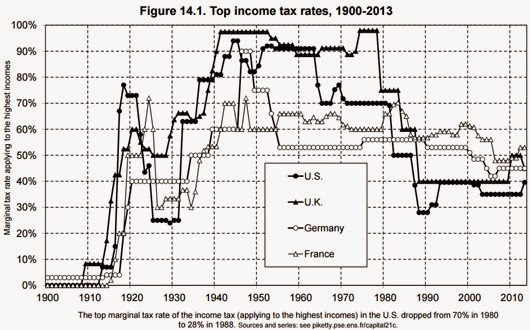ピケティの資本論 9: 格差を強固にするもの 2

< 1. a catastrophic plunge in stock prices of New York >
< 1. ニューヨーク株価大暴落 >
Last time, we looked at the underclass became poor more and the inequality was strengthened.
This time, we look at a wealthy class became richer and the inequality was strengthened.
前回、低所得層がより困窮し、格差が強化される状況を見ました。
今回は、富裕層がより豊かになり、格差が強化される状況を見ます。
The income decline of underclass and the income increase of wealthy class come out of unitary construction
What would happen to the wealthy class that should have lost many assets at every financial crisis?
When I see an American economic data, they achieved recovery by several years and rather had more large assets.
We will see the situation.
低所得層の所得低下と富裕層の所得増大は一体構造から生まれる
金融危機の度に多くの資産を失ったはずの富裕層はどうなったでしょうか?
米国の経済データーを見ると、数年で復活を遂げ、むしろより多くの資産を持つようになっている。
その状況を見てみましょう。
< 2. American economic recessions, vertical axis: unemployment rate, transverse axis: number of months >
< 2.米国の景気後退期の比較、縦軸:失業率、横軸:月数、>
Explanation: it shows the biggest unemployment rates of the 11 recessions and its periods.
Between this recession periods, being distressed mostly was the underclass.
And for super-rich people, it was the chance of the jump that becomes richer.
解説: 11回の景気後退期の最大失業率とその期間がわかります。
この後退期に、苦渋を多く舐めるのは低所得層でした。
かつ超富裕層がより豊かになる飛躍の機会でもありました。
< graph 3. proportions of income of the top 10 % in America, by“Capital in Twenty-First Century” >
< 3. 米国におけるトップ十分位の所得占有率、ピケティ「21世紀の資本」より >
Explanation: it shows the proportion of the income of top 1%, top 5%-1%, and top 10%-5% in American total incomes.
After 1980, the proportion of income (8-24%) of the top 1% goes down once each economic recession period of graph 2, but suddenly recovers afterwards and increases more.
The proportion of the income of top 10 in American total incomes increased rapidly, it became 48 % in 2010, and the tendency is remarkable as more rich class.
解説: 所得上位1%、5―1%、10―5%層の所得が全米総所得に占める率を示す。
1980年以降、最上位1%の所得占有率(8~24%)がグラフ2の景気後退毎に一度下がるが、その後急激に回復し、より増大している。
所得上位10%の全米所得の所得占有率は急速に増大し、2010年で48%に至り、所得の多い人ほどその傾向が著しい。
What is taking place?
This mechanism is simple, and is to help the cause banks and investment companies by our national tax for emergency countermeasures of government after a collapse of bubble economy.
On the other hand, the government reduced the tax amount from the expense used for the relief of the socially vulnerable, and the underclass became to suffer more.
何が起きているのか
このからくりは単純で、バブル崩壊後の政府の緊急対策で、元凶の銀行、投資会社を国民の税金で助けることにあります。
一方、これに回された税金分だけ弱者対策の費用削減になり、米国の場合、皆保険制度の縮小になり、弱者を苦しめることになる。
“If banks are smashed, it becomes the true Great Depression, and it becomes serious damage having to need ten years or more for revival”
In this way, surprised people have gone to bed crying.
I cannot say badly about doing a financial crisis calm by money supply.
But it is same as helping a diabetic that continues food satiation with insulin repeatedly, and only worsens him after all.
「もし銀行などを潰せば、本当の大恐慌になり、復活に10年以上を要し被害は甚大となる」
こうして驚かされた国民は泣き寝入りすることになる。
金融危機を貨幣供給で沈静化させることが間違っているとは言えないが、所詮、飽食を続ける糖尿病患者にインスリンでその場しのぎを繰り返し、悪化させているだけです。
Having contributed to income increase of the top 1 % in graph 3 was capital gain (profits of stock and credit).
Central bank issues lots of currency for economic recovery (monetary easing), and the excess funds of wealthy class and companies invest in speculation, and it invites the next bigger economic bubble.
And if they fail, they are helped also.
グラフ3の所得上位1%の所得増大に大きく寄与しているのはキャピタルゲイン(株・債権の売買益)でした。
これは、中央銀行が景気回復の為(金融緩和)と称して通貨を大量に発行し、富裕層や企業の余剰資金は投機に回り、次のより大きなバブルを招いているからです。
そしてまた失敗すれば助けるのです。
< 4. a change of currency circulation of major countries >
< 4.主要国の通貨発行高の推移 >
Explanation: The currency circulations of each central bank are all higher than the GDP growth rate, but only it of Japan (blue line) is low level.
As a result, it became appreciating yen, but the influence of the Lehman shock in 2007 became slight adversely.
What did take place by it?
解説: 各国中央銀行の通貨発行量はいずれもGDP成長率よりも高いが、日本の通貨発行量(青線)だけが低水準です。
この結果、円高になったが、逆に2007年のリーマンショックの影響が軽微になった。
(日本は成長率が零に近いので、この低い通貨発行量でもGDP成長率よりも著しく高い。)
この結果、何が起こったのでしょうか。
< 5. a change of total stock price in the world main market >
< 5. 世界主要市場の株価時価総額の推移 >
The difference of the world total stock price in 2007 and 2008 in graph 5 is 7,200 trillion yen (120 yen/dollar).
The difference of Japan exceeds 200 trillion yen, and is equivalent to about half of the GDP.
Only people to be able to ride on this insubstantial thing are possible to continue increasing assets.
Thus, at every economic bubble burst, the inequality of underclass (the weak) and wealthy class spread more.
If it is left unsolved, it keeps deteriorating.
グラフ5の2007年と2008年における世界の株価時価総額の差は7200兆円(120円/ドル)です。
日本でもその差は200兆円を超え、GDPの約半分に相当します。
この実体の無いものに便乗し操れる人々は、資産を増やし続けることが可能です。
こうしてバブル崩壊毎に、低所得層(弱者)と富裕層の経済格差はより拡大していきます。
このことは多くの先進国で大なり小なり起きていることで、放置すれば悪化するばかりです。
< 6. the top marginal tax rate of the income tax in main countries, by“Capital in Twenty-First Century” >
< 6. 主要国における所得税の最高税率の推移、ピケティ「21世紀の資本」より >
Explanation: USA and United Kingdom decided on a progressive tax for the inequality reduction as a forerunner in the world once.
解説: 米国と英国はかつて世界に先駆けて、格差縮小のために累進課税に踏み切った。
In fact, government caused the inequality expansion
The asset increase of wealthy class was not taking place in graph 3 from 1940 to 1980.
This is because the U.S. government imposed high progressive taxation (inheritance tax, income tax) of graph 6 only during this period.
In other words, current unhappy result occurred because the U.S. government supported wealthy class in the taxation system and monetary policy.
Besides, the world has imitated this competitively.
The policy change of government is necessary to stop the vicious circle of the economic bubble burst, and to prevent inequality expansion.
Economist Krugman blames the American policy change after 1980 's thoroughly in “ The conscience of a liberal”
And Piketty also is similar.
This continues next time.
実は、政府が格差拡大を招いた
グラフ3で1940~1980年の間は、富裕層の資産拡大は起きていませんでした。
これは米政府がこの期間だけ、グラフ6の高率の累進課税(相続税、所得税)を課していたからです。
つまり米政府が税制と金融政策で富裕層を支援したことから、現在の不幸な結果が生じているのです。
しかもこれを世界が競って真似してしまったのです。
バブル崩壊の悪循環を断ち、格差拡大を防ぐには、政府の政策変更が必要なのです。
クルーグマンは「格差はつくられた」で米国の1980年代以降の政策転換を徹底的に批難しています。
ピケティも著書で、これを世界先進国の潮流として冷静に分析し実態を白日の下に曝しています。
次回に続きます。






No comments:
Post a Comment